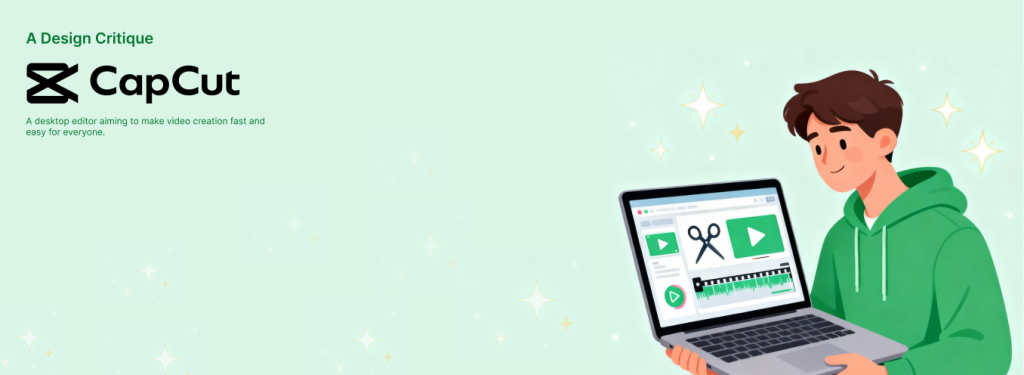Introduction
CapCut for Mac is a desktop video editor that aims to make video editing fast and approachable while offering a broad set of features. The experience is sleek and simple, but some design choices create friction around onboarding, visibility, sharing and error recovery especially for new users.
Getting Started: Registration & Onboarding
Right away, CapCut’s large, well-labeled “Create Project” and “Import” buttons provide strong signifiers; their size, position, and icons map closely to their purpose affordance. Without a doubt, the conceptual model presented here matches a user’s expectation, “this is where I start.” When you click Import, feedback is immediate and files show up in the media bin in seconds, reducing uncertainty visibility and feedback.

However, the next step is less clear. The timeline shows a small ‘drag material here’ message, but it’s subtle and easy to miss. Someone new to editing might stop and wonder what to do next, making the interface less discoverable, a missed opportunity highlighted in The Design of Everyday Things.
Another friction point is that project settings like aspect ratio and file type are selected by default, without asking the user’s intent. A beginner creating for TikTok versus YouTube shouldn’t have to select, modify and change the settings.

Pop-up tooltips option would bridge the gulf of execution. This temporary guidance would afford making obvious actions like importing and dragging to the timeline, supporting both visibility and mapping for new users. Making the hidden steps visible helps everyone form a better conceptual model, reducing friction, and letting users feel instantly empowered.
Also having a step to select which platform the project is for when creating a project and generate a matching file setup automatically, and still allow custom sizing for users aligns the system’s mapping with the user’s mental model, reducing the risk of starting wrong and backtracking later.
The Editing Flow: Visibility, Feedback, and Affordances
The core editing tools are visible, icons are familiar, and trimming or splitting gives immediate playback feedback bridging intention and result. Filters and effects are especially clear, when applied, they overlay directly on the clip, so users can easily see what’s active.
Visibility break down is with transitions, These appear only as a thin grey bar between clips, often overlooked by beginners. There’s no strong signifier that something has been applied, weakening both mapping and discoverability.
Adding a distinct colour and the name of the transition would make it visually distinct. This would strengthen feedback and reduce ambiguity.

Premium Features and Export Friction: Visibility and Feedback
CapCut offers a wide range of transitions and effects, but many are locked behind the Pro subscription. The issue is visibility: the Pro badge is small and easy to miss, and once applied, there’s no persistent cue on the clip that a premium feature is in use. The problem only surfaces at the very end when a user clicks Export and is told they must upgrade to Pro before continuing. By this point, they’ve already invested time editing, making the forced paywall feel frustrating and deceptive.


Flagging the pro features implemented with a color badge and showing a clear indicator on the clip once applied would help the user understand the use of premium features in the edit even before they click on export. having the pro features grouped separately from the free features would reduce the confusion.
As Norman emphasizes, good design prevents unpleasant surprises. By making constraints visible earlier and mapping export outcomes to user choices, CapCut could turn frustration into transparency and maybe even higher conversions to Pro.
Mistakes and Error Recovery: Affordances and Constraints
CapCut enforces helpful constraints that prevent major errors: you can’t accidentally drop audio into a video track or export unfinished timelines . These forcing functions prevent unintentional outcomes and help users recover before disaster. The Undo/Redo buttons afford reversal, but no clear label of what is being undone or history.

Not knowing what you’re about to undo causes anxiety. An edit history panel, with timestamped actions and context-aware Undo labels, would invite confident experimentation and lower the risk of accidental deletions. Showing history in this way also leverages the affordance of reversibility.
Conclusion
CapCut for Mac has strong affordances and signifiers for starting new projects, visible tools for editing, and instant feedback for core actions. Yet if CapCut addressed the subtle discoverability gaps in onboarding, made transitions more visible, improved transparency around premium features, and offered a clear error recovery history, it would move even closer to Norman’s ideal technology that “just works,” enabling creativity for all. A few nudges toward better visibility, mapping, and recoverability and a little more attention to how users perceive artifacts’ affordances would give the users a better experience.
